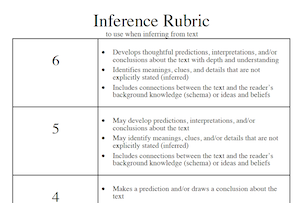An Inference Rubric to Gauge Comprehension
 Literacy teacher and coach Juli Kendall passed away in 2006 after a long battle with ovarian cancer. For several years Juli (far right in photo) was not only active in our MiddleWeb listserv community but wrote a “reading and writing workshop journal” for MiddleWeb (these were the years before blogging became easy and popular).
Literacy teacher and coach Juli Kendall passed away in 2006 after a long battle with ovarian cancer. For several years Juli (far right in photo) was not only active in our MiddleWeb listserv community but wrote a “reading and writing workshop journal” for MiddleWeb (these were the years before blogging became easy and popular).
This post about her inference rubric for gauging student understanding in academic subjects is still sought out by teachers. Juli’s timeless writings about literacy can be found in her books for Routledge/Stenhouse, co-authored with Outey Khuon, still available in 2024.
Juli Kendall’s Inference Rubric
Download the Inference Rubric (PDF file)
Juli Kendall is posting this inference rubric in the hope that it will prove useful to middle grades teachers looking for a tool to assess inference skills across the curriculum. Here’s her explanation.
I made the decision very early on in the writing of my journals to focus on reading (book selection, reading aloud, running records, shared reading, guided reading, just right books, talking about books, thinking aloud about books, etc.) rather than writing and the writing response.
Therefore, I have not covered Reading Logs, Reading Journals, or Reading Notebooks, although I have always used them with my students. I felt that middle grades teachers have much more background in writing, and this Workshop project could allow us to cover less familiar territory — talking about reading to build understandings.
I did decide to devote a section of Reading Workshop to content area reading since it is so important in middle school. And since I am teaching in elementary this year, I can so clearly see that teachers are not always teaching kids “how to do it.”
As I was working on my journal about content area reading, I went back through all my middle school material and found my rubric on inference. I have used it only a little this year — just enough to see that my kids (who are really repeating fifth grade) are not using much inference in their writing responses yet. I hope some of my readers will find this rubric useful, and perhaps it will spark some curiosity and conversation.
Background about the inference rubric
 The Inference Rubric came about because of the collaboration on reading in all content areas at Hill Middle School, where I taught for quite a few years. I worked as the Literacy Standards Coach for reading and developed a rubric for each of our focus areas.
The Inference Rubric came about because of the collaboration on reading in all content areas at Hill Middle School, where I taught for quite a few years. I worked as the Literacy Standards Coach for reading and developed a rubric for each of our focus areas.
My team would try out the rubrics and give me feedback about their experiences. Then I would take all the suggestions from the different content areas and try to weave it into a working rubric.
The Inference rubric was always a challenge. The idea was that students would have reading response logs in all content areas and that they would use them to write a response to their reading for math, art, science, history, PE, literature, music, etc. Then the challenge became “how can we know that they are using the strategies we are teaching?” Thus, the rubric.
It was meant to be something that could be used across content areas to evaluate a student’s response to see what level of inference was involved after inference had been taught. It could be in response to a prompt or just an open invitation to write.
This opportunity to respond to reading by writing is important in content area reading. But then, how do we evaluate it? After reading lots of journals, these were the three qualities of inferring from text that stood out.
• Thoughtful predictions, interpretations, and/or conclusions about the text with depth and understanding
• Meanings, clues, and details that are not explicitly stated (inferred)
• Connections between the text and the reader’s background knowledge (schema) or ideas and beliefs
The inference rubric made it possible for teachers to talk about student’s work in responding to reading across content areas. A science teacher would give a 3 to a written response in science, a math teacher would give a 4 for one in math and they could have a conversation about the level of inference the student was using and not have to deal so much with the “assignment” issue. It made for some interesting “Looking at Student Work” discussions.
One year, our entire school (Hill) focused on just one strategy — using Inference to understand what you read. The rubric proved to be a useful tool for us. I hope you find good uses for it, too.

































